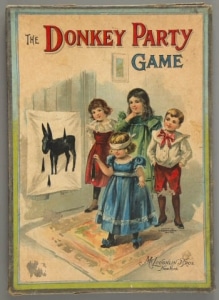 What sort of party games stick in your memory? No, not the ones from your teen years which involved getting your first kiss. I’m thinking of the classic party games for children’s birthday parties. And one of the top party games for that demographic—at least in my childhood—would have to be Pin the Tail on the Donkey. The earliest donkey pinning games in The Strong museum’s collection come from the 1890s, which aligns with accounts from the internet (because you can always trust that, right?) saying that the game originated from rural areas in Wisconsin in the 1880s, when it seems to have just been called the Donkey Party Game.
What sort of party games stick in your memory? No, not the ones from your teen years which involved getting your first kiss. I’m thinking of the classic party games for children’s birthday parties. And one of the top party games for that demographic—at least in my childhood—would have to be Pin the Tail on the Donkey. The earliest donkey pinning games in The Strong museum’s collection come from the 1890s, which aligns with accounts from the internet (because you can always trust that, right?) saying that the game originated from rural areas in Wisconsin in the 1880s, when it seems to have just been called the Donkey Party Game.
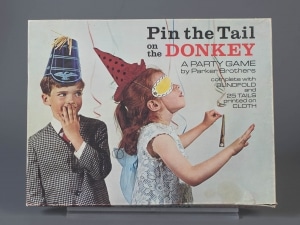 The box cover of a Parker Brothers version of the game from about 1965 makes clear the true appeal of all the pin-the-tail games—they provided a wonderful opportunity to humiliate your friends, siblings, or classmates—whoever was there at your birthday party. The true hilarity came from blindfolding that willing victim, spinning them around, and then sending them off toward the donkey target on the wall, eagerly anticipating that the tail would wind up on the poor animal’s head, floating in the background—any place except where it belongs.
The box cover of a Parker Brothers version of the game from about 1965 makes clear the true appeal of all the pin-the-tail games—they provided a wonderful opportunity to humiliate your friends, siblings, or classmates—whoever was there at your birthday party. The true hilarity came from blindfolding that willing victim, spinning them around, and then sending them off toward the donkey target on the wall, eagerly anticipating that the tail would wind up on the poor animal’s head, floating in the background—any place except where it belongs.
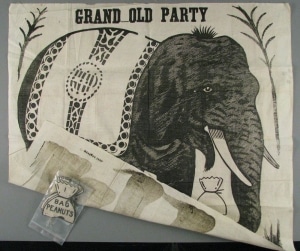 What you might not guess unless you’re a curator at the biggest toy museum in the world is that donkeys are far from the only subject matter for pin-the-tail games. If you’re of a political bent—because what child isn’t—you could opt for a game that involved an elephant, the symbol of the Republican Party, in the Grand Old Party game. In comparison to its overall size, an elephant’s tail is pretty negligible, so the pinning items for the game consist of bags of peanuts. Which, in turn, has led The Strong’s curators to jokingly refer to this version as Pin the Peanuts on the Pachyderm.
What you might not guess unless you’re a curator at the biggest toy museum in the world is that donkeys are far from the only subject matter for pin-the-tail games. If you’re of a political bent—because what child isn’t—you could opt for a game that involved an elephant, the symbol of the Republican Party, in the Grand Old Party game. In comparison to its overall size, an elephant’s tail is pretty negligible, so the pinning items for the game consist of bags of peanuts. Which, in turn, has led The Strong’s curators to jokingly refer to this version as Pin the Peanuts on the Pachyderm.
Probably more to the true taste of kids is Our Cinderella Party. The illustration on linen shows a pensive Cinderella resting from her labors by the fireplace with her broom and dustpan for sweeping up the ashes. She’s much humbler looking to my eye than the standard glamorous Disney princess Cinderella, even before she gets spruced up to go to the ball. However, the best part for me is that this Cinderella is wearing what seem to be a very early version of UGG boots, although the challenge is to place one of the golden pumps on her bare foot.
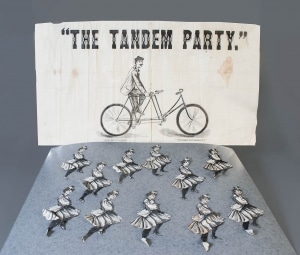 Equally interesting is The Tandem Party from 1897, the time of a nationwide craze for bicycling. Before this period, only a few daring cyclists were willing to teeter down rutted pavements on treacherous high-wheeled bicycles with no brakes. With the advent of what was called the safety bicycle—with two wheels of the same size, more comfortable seats, and useful brakes—bicycling became an outdoor activity for everyone, boys and girls, women and men. Bicycling could even be a social or romantic activity with a tandem bicycle and the right bicycling partner. The background for The Tandem Party shows a mustachioed chap on the back seat of a tandem. He’s obviously looking for the right bicycling mate and the players aspire to get a lovely bicycling lady with a practical knee-length skirt (so it wouldn’t get caught in the chain or the wheels) onto the front seat of the bicycle.
Equally interesting is The Tandem Party from 1897, the time of a nationwide craze for bicycling. Before this period, only a few daring cyclists were willing to teeter down rutted pavements on treacherous high-wheeled bicycles with no brakes. With the advent of what was called the safety bicycle—with two wheels of the same size, more comfortable seats, and useful brakes—bicycling became an outdoor activity for everyone, boys and girls, women and men. Bicycling could even be a social or romantic activity with a tandem bicycle and the right bicycling partner. The background for The Tandem Party shows a mustachioed chap on the back seat of a tandem. He’s obviously looking for the right bicycling mate and the players aspire to get a lovely bicycling lady with a practical knee-length skirt (so it wouldn’t get caught in the chain or the wheels) onto the front seat of the bicycle.
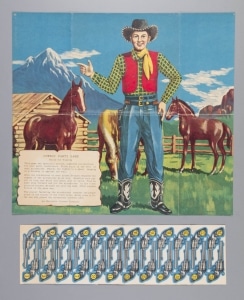 Last but certainly not least is the Cowboy Party Game. American popular culture in the mid-1950s seemed to be crazy for all things Western. The television series Gunsmoke featuring Sheriff Matt Dillon made its debut in 1955 and would go on to run for two decades. If you liked your cowboys singing, the fifth most successful movie at the box office that year was Oklahoma! And the Cowboy Party Game let kids try their aim at placing a pistol in the hand of a smiling cowpoke in a blazing red vest.
Last but certainly not least is the Cowboy Party Game. American popular culture in the mid-1950s seemed to be crazy for all things Western. The television series Gunsmoke featuring Sheriff Matt Dillon made its debut in 1955 and would go on to run for two decades. If you liked your cowboys singing, the fifth most successful movie at the box office that year was Oklahoma! And the Cowboy Party Game let kids try their aim at placing a pistol in the hand of a smiling cowpoke in a blazing red vest.
I hope that maybe I’ve given you inspiration to break out of that donkey rut in your party games. Maybe you even want to create a pin-the-tail game of your own that suits your own interests. Why not grab your markers and design a totally fresh variation? And, when you do, snap a picture or two so you can share your creation with The Strong’s Play Stories project, dedicated to gathering, preserving, and sharing stories, images, and videos about play in 2020. Because when a game’s a classic, it always deserves a fresh spin for our own time.



